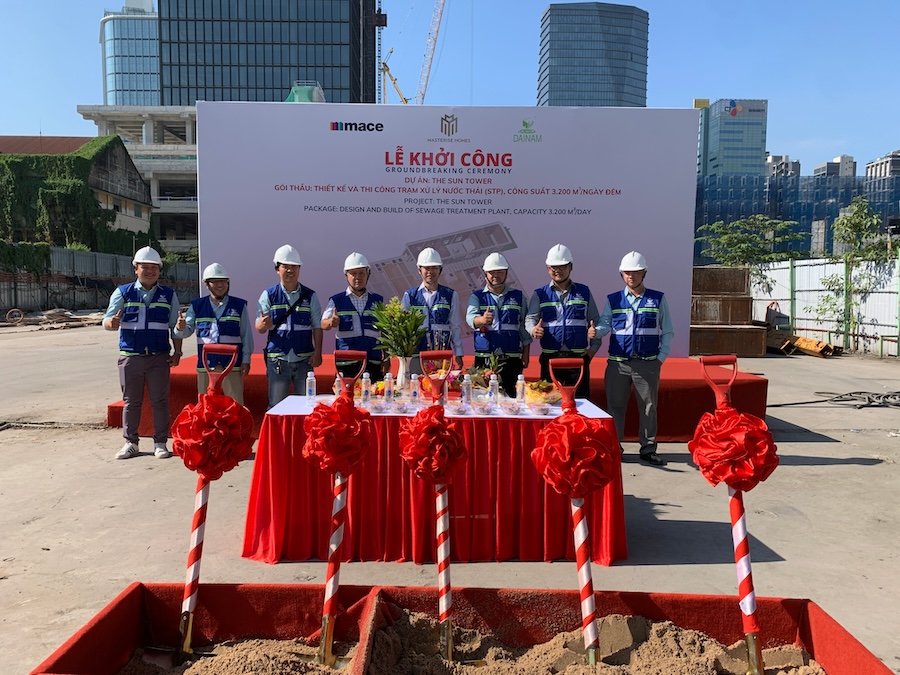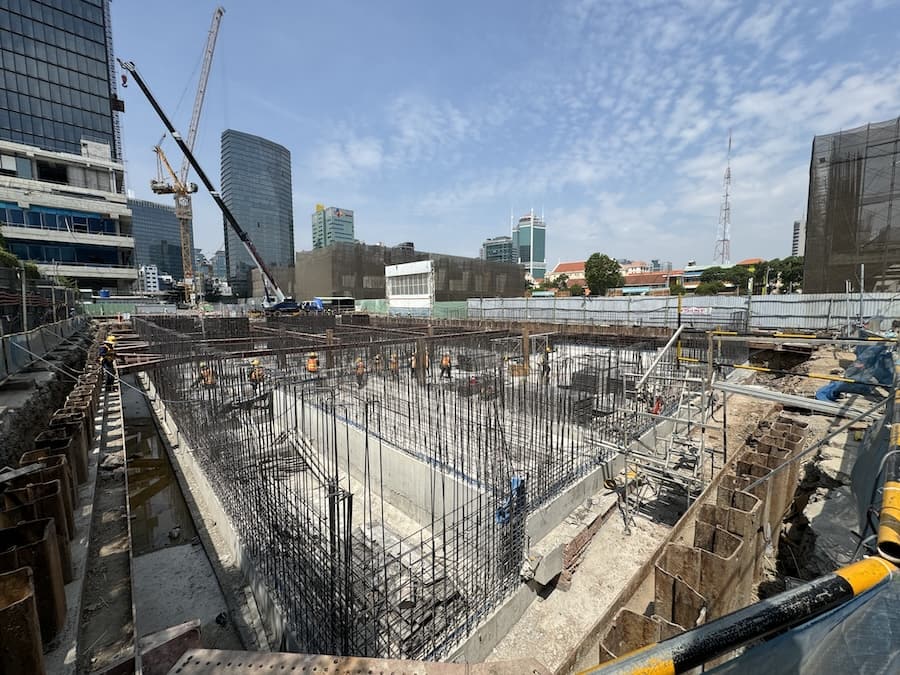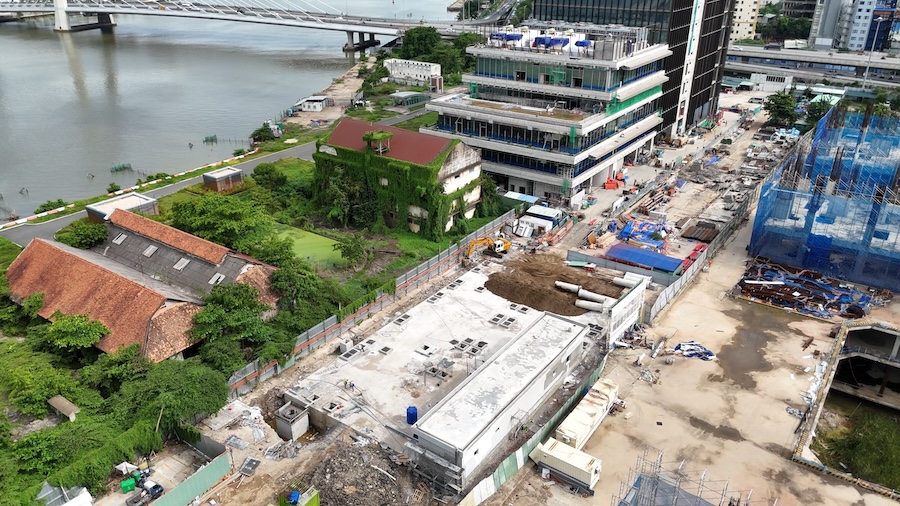Amid the rapid pace of modern urban development in Ho Chi Minh City, The Sun Tower Ba Son in District 1 emerges as a landmark of luxury and sustainability. Through a strategic partnership with Dai Nam Environmental Solutions Co., Ltd. – a reputable and professional company in the field of wastewater treatment solutions – the project not only aims to create a premium living and working space but also places strong emphasis on environmental protection. With extensive experience and deep industry expertise, Dai Nam is proud to accompany The Sun Tower Ba Son, delivering optimal and sustainable solutions that help build a prosperous, nature-friendly urban community.
1. Project Introduction: The Sun Tower Ba Son
-
Project Name: Office, commercial, and service tower located on land lot VP2 within the Saigon – Ba Son complex
-
Capacity: 3,200 m³/day and night
-
Investor: Capitaland Tower Co., Ltd.
-
Project Address: 2 Ton Duc Thang Street, Ben Nghe Ward, District 1, Ho Chi Minh City
-
Environmental Contractor: Dai Nam Environmental Solutions Co., Ltd.
-
Company Address: 144 Chu Van An Street, Ward 26, Binh Thanh District, Ho Chi Minh City
Strategically located in the heart of District 1 within the historically rich Ba Son area, The Sun Tower Ba Son is a standout project at 2 Ton Duc Thang Street, Ben Nghe Ward. Developed in collaboration between Masterise Homes and Capitaland – two leading names in real estate – the tower benefits from a prime riverside location along the Saigon River and direct access to Ba Son Station on Metro Line No.1, offering unmatched convenience for residents and businesses alike.
Designed as a multifunctional complex, the development features high-end residences, Grade A office spaces, and a premium shopping center. The tower boasts 55 above-ground floors and 5 basement levels, with a total construction floor area of over 106,000 m². One of its most striking architectural features is a series of hanging gardens from the 35th to 43rd floor, providing a modern and distinctive green space in the heart of the city. The project is also targeting LEED Gold certification, reinforcing its commitment to sustainability and environmental friendliness.
With its “diamond” location at the intersection of Ton Duc Thang and Nguyen Huu Canh streets, The Sun Tower Ba Son is not only an ideal living space but also a top choice for domestic and international businesses. It is equipped with first-class amenities including a swimming pool, gym, luxury lounge, and commercial center. The project is set to shape a new economic and cultural hub and elevate the urban landscape along the Saigon River.
.jpg)
The Sun Tower Ba Son is a landmark development strategically located in the heart of District 1, Ho Chi Minh City
2. Overview of Wastewater Treatment Technology at The Sun Tower Ba Son
2.1 Collection and Screening Tank
Before entering the tank, wastewater is filtered through a coarse basket screen (5–10 mm holes, SUS304) to remove large debris (10–20 mm) and prevent clogging of pumps and pipelines. Collected waste is manually removed and disposed of in compliance with regulations. The collection tank gathers wastewater before pumping it to the grease trap.
2.2 Grease Trap Tank
Prior to entering the tank, wastewater passes through a fine basket screen (3–5 mm holes, SUS304) to eliminate smaller debris and prevent blockages in downstream systems. The collected waste is removed manually on a scheduled basis. Since domestic wastewater contains grease and oils, it must be separated to meet QCVN 14:2008/BTNMT, Column A standards. The three-compartment grease trap works on a gravity separation principle, where lighter oils float to the surface and are manually skimmed and treated. The treated water then flows naturally to the equalization tank.
2.3 Equalization Tank
This tank is designed with a long retention time to stabilize flow and pollutant concentrations. Benefits include:
-
Storing and evenly distributing wastewater during peak hours
-
Controlling high pollutant loads
-
Preventing overload of downstream treatment units
-
Holding wastewater during maintenance
-
Partially degrading solids before biological treatment
A submersible mixer ensures thorough mixing, minimizes anaerobic decomposition, and controls odors. Wastewater is then pumped to the anoxic tank.
2.4 Anoxic Tank
In the anoxic tank, nitrate and nitrite are reduced to nitrogen gas (N₂), which is released into the environment. This tank receives nitrate-rich water from the recirculation line and combines with return activated sludge from the secondary clarifier to sustain treatment efficiency. Alkaline and nutrient dosing adjusts pH and provides carbon to support microbial activity. The nitrate removal reaction from COD is as follows:
C₁₀H₁₉O₃N + 10 NO₃⁻ → 5 N₂ + 10 CO₂ + 3 H₂O + NH₃ + 10 OH⁻
A submersible mixer ensures even distribution of wastewater and sludge, improving treatment effectiveness. The water then flows naturally into the aerobic MBBR tank.
2.5 MBBR Tank
The Moving Bed Biofilm Reactor (MBBR) utilizes suspended bio-carriers for aerobic treatment, where microorganisms attach to the media to break down organic compounds. These carriers offer high surface area for biomass retention, enhancing treatment performance while saving space. In a continuously aerated environment, carriers circulate and form a three-layer biofilm: anaerobic (inner), anoxic (middle), and aerobic (outer), enabling superior removal of nitrogen, phosphorus, and BOD compared to conventional activated sludge systems. Air blowers and diffusers provide oxygen to support microbial decomposition of pollutants into simple inorganic compounds.
2.6 Aerotank
The aerotank serves two main purposes:
-
Reduce organic matter via autotrophic aerobic microorganisms
-
Facilitate nitrification (conversion to NO₃⁻ for upstream anoxic denitrification by Nitrosomonas and Nitrobacter)
Continuous aeration supplies oxygen for microbial degradation of organics into CO₂ and H₂O, while also synthesizing nutrients (N, P) for cell growth. Organic removal is prioritized, with residuals left for nitrification. Suspended sludge is maintained through aeration, with part of the return sludge looped back to the anoxic tank to maintain system balance. The nitrate-rich stream is recirculated to aid nitrogen removal. The effluent then flows to the secondary clarifier.
2.7 Secondary Clarifier
Post-biological treatment, wastewater contains a high concentration of suspended activated sludge that must be separated. The clarifier uses gravity settling to separate biomass flocs into three zones: clarified water, settling zone, and sludge zone. Wastewater enters a central pipe, distributing flow evenly; sludge settles to the bottom while clear water overflows through a weir into the disinfection tank. Sludge is scraped to the central hopper and directed to a sludge pit; part is returned to the anoxic tank and excess is pumped to the sludge holding tank.
2.8 Disinfection Tank
Clarified water from the secondary clarifier flows by gravity into the disinfection tank. Sodium hypochlorite (NaOCl or "Javen"), a cost-effective and efficient disinfectant, is dosed to eliminate pathogens. Disinfection occurs in two stages: the chemical first penetrates the microbial cell wall and then reacts with intracellular enzymes, disrupting metabolism and killing the organisms.
2.9 Monitoring Channel
Treated wastewater is discharged into the monitoring channel. In accordance with Circular 10/2021/TT-BTNMT, treatment plants with a capacity above 1,000 m³/day must be equipped with a continuous automatic monitoring station. This station ensures the effluent meets QCVN 14:2008/BTNMT, Column A. The station is equipped with sensors (for pH, COD, TSS, flow), data storage, auto-samplers, cameras, and real-time data transmission to the Department of Natural Resources and Environment (DONRE). It operates automatically, providing accurate daily data for monitoring discharge quality.
2.10 Sludge Treatment Plan
Sludge from wastewater treatment can cause long-term environmental pollution, degrade water quality, generate odors, and impact ecosystems and public health if not properly managed. Therefore, sludge treatment is a critical component of the overall domestic wastewater treatment system.

Groundbreaking Ceremony of The Sun Tower Project
Topping-Out Ceremony of The Sun Tower Project
Construction Process of Dai Nam's Wastewater Treatment System
Overview of the Wastewater Treatment System at The Sun Tower During Construction
Completed Wastewater Treatment System at The Sun Tower – Final Construction Images
The domestic wastewater treatment system at the Dai Nam project is designed and constructed in accordance with national standards, ensuring compliance with QCVN 14:2008/BTNMT, Column A. The implementation of this system at Dai Nam demonstrates a strong commitment to advanced environmental technology, contributing to environmental protection, ecosystem preservation, and improved quality of life for the community—aligning with the region’s sustainable development goals.
.jpg)

.jpg)


.jpg)